Olive oil and wine are the ancient equivalent of petrol and narcotics
Olive oil and wine are the ancient equivalent of petrol and narcotics. There is a lot of money in them. There always has been. They are intertwined in the mythic foundations of Mediterranean culture. They have played important roles in the development of just about every aspect of early European civilization; the developing city-state, religion, food, economics and commerce. The Amphorae made to hold them both clutter the seabeds of this Mare Nostrum.
Amphora gardens of the archeological museum of Adana
There are so many types of Vitis Vinifera , the wine-producing grape vine. The famous varietals everyone knows. Minerally Chardonnay from Burgundy and often buttery oaked from California, austere old-fashioned Cabernet from Bordeaux or heady fruity intense from Napa. Gastronomically polyvalent Nebbiola from Italy and, an incredibly rich version from Mexico (yes Domecq makes a stellar Nebbiolo) There are thousands of wine grape hybrids catalogued.
Cluster of grapes in Burgundy
Just so there are an estimated 2,000 varietals of Olea Europaea, the olive tree that yields the bitter, green, liquid gold. And these EVOOs, like wine, have become associated with either their birthplaces or the lands where they thrive. The mix of terroir, climate, varietal, and production combine to give us this miraculous substance that speaks of the spirit of a place and is an integral part of some of the greatest cuisines in the world. (From amuse-bouche to dessert; there are Spanish, Italian, Portuguese and Provencal chefs who use a different oil with every course of a meal, to be concluded with a dark chocolate-olive-oil mousse!)
An EVOO-rich appetizer in Taormina a parfait of melanzane alla parmigana
Olive oil has always served, as seasoning, food, fuel, a light source (Roman oil lamps from Syria to Britain are one of the most common antiquities, they make a nice archeological artifact to buy as they are often inexpensive) a perfume, a lubricant, a source for soap and massage oil. The wood of the tree makes tools and burns hot. It has been use to preserve both fruits for the market and the bodies of dead kings to be brought home for burial.
(From here on out let's say "EVOO" . I will use the abbreviation for convenience, but I do so love writing "Extra Virgin", it sounds like the ripest cherry waiting to be plucked from the tree seconds before it would fall off of its own accord, a convent-educated beauty about to put on a little black dress and go on her first date, I could wax poetical at length, it should never be pronounced--as it is so often--"estravirginahlifoil" but slowly and sensually with a long pause "Extra" one beat then drawing out the initial fricative "V-irgin" two beats "Olive Oil". If you haven't yet fallen in love with both wine and EVOO, this may all appear a little loony to you. But once you have the epiphany, you will understand. A little sea salt, a grilled vegetable or piece of fish, the right Extra Virgin Olive Oil and glass of wine and you will never be the same.)
A Few Examples of the vast variety of Olea
Throughout Italy there is the magnificent Sweet-hay Frantoio. There are the Correggiolo, Moraiolo, and Leccino and Canino used to make the celebrated magical oils of Tuscany and Umbria. there are hot Bosana from Sardinia and bitter earthy Coratina in Puglia. The meaty, fresh and delicate water-cured Castelvetrano from Sicily that with the a glass of Grillo can take the place of a meal. The inimitable taggiasca from Liguria, and the Gaeta from Lazio.
In Spain and Portugal there are hundreds. Though just four make up over half of the planted surface of Spanish orchards: The Picual, Hojiblanca from Cordoba with its sweet finish, Cornicabra the "goat's horn", then delicate Arbequina from up in Catalonia (now I believe the most common in California).
There are hundreds of uncatalogged olive types in Greece and Turkey. Of the known olives, which to name? How about the Greek Kalamata, reigning king of table olives.
From France there is the almondy Lucques from Languedoc that thinks it is from Lucca in Italy. The pointy, elongated picholine like the delicious end of an erect nipple, sprouting from ancient trees, like those over thousand years old basking in the sun under the majesty of the Pont du Gard. There are the Salonenque and Grossane from the AOC Les Baux de Provence and the routes des Grands Crus of French olive oil.
Pont du Gard source: Wikimedia Commons
1100 year olive tree near the Pont du Gard source: Wikimedia Commons
North Africa has a mix of Spanish and French (Picholine, Arbequina) a few documented indigenous cultivars and a few exotics. Dahbia from Morocco. In Tunisia there is Chemlali near Sfax and there is Chétoui in the North.
And last, there are the often canned Mission olives of California ubiquitous on many an American Thanksgiving dinner table, which are the only catalogued U.S. cultivar.
Fraud
Like Grands Crus Wines, EVOOs are sought after. And also like wines: quality and quantity are generally inversely proportional. Rarity and demand create high prices and a situation ripe for corrupting influences.
Fraud in the Extra Virgin Olive Oil trade across the entire mediterranean basin is a story going at least as far back as Classical Greece. And particularly the fraud between Italy, North Africa and Spain. There are many references to the problem during the Roman Republic. It was later partly responsible for the rise and fall of several imperial dynasties. Amphora closed with imperial seals showing the origin of the shipment, backed by roman law and inspections represented a much more sophisticated system of traceability than we have today. But there was still fraud on a huge scale.
Art expo Paris Westin, a thief in the Vineyard
There are of course serious problems caused by some of the contemporary frauds. Things that might be dangerous to your health are sometimes being passed off as quality oil. But on the higher end of the market, where consumers are competing to get their hands on great olive oils, like fine wines, there is another, older story.
The money in EVVOs is about quality and prestige (sometimes though not always both at the same time). Make good oil that will fool the palate of a connoisseur, for less money than an expensive one, and change the label. Stretch and bulk up the body of a Tuscan oil in a difficult harvest year with a little cheaper oil from somewhere else (a process that is known as Hermitager in Bordeaux where it used to be a little more common than you might think to import some wine from the northern Rhone valley and add it to a Chateau with a Cru Classé of 1855). There are a lot of good tricks. And Presto! Money for nothing and, uhm, the-person-of-your-prefered-gender for free. (The same incentive was there during the Roman Empire. Plus ça change....)
Is this always a bad thing for everyone, consumer, producer, the global economy, developing countries? Not necessarily. Sometimes it even helps create more great oil at more affordable prices.
For most of the twentieth century the Mezzogiorno used to produce huge amounts of industrial-grade oil and most of the good stuff was in tiny quantities made by families for their own use. Yields are much higher in the south. A tree in Puglia can possibly produce up to 20 liters per annum while in Tuscany the average is sometimes as low as 1 liter per tree. Frosts can come early in the north and harm the harvest. Labor is more expensive. So boatloads of oil would get shipped up from Puglia, Calabria and Sicily to Genoa and Livorno to be blended and bottled as Tuscan or Ligurian then sold mostly in the UK, the US and Germany. Both Italian and foreign appreciation of EVOO grew during the seventies and early eighties. At the same time the quasi monopoly of industrial agriculture by organized crime was diminishing considerably. Great small-production EVOOs (and quality wines which so often follow the same story) began to flourish across the south of the country. So while Tuscan oils are still sought after, so are many from the south. Prices rose, and it became profitable to make and market regional EVOO (And this made the best northern Italian oils more expensive and harder to acquire, while incentivizing even more fraud). And then the EU stepped in with agricultural improvement projects and helped speed up this development.
25 years ago it was much harder to find a true non-industrial quality EVOO from Spain. It was then the Spanish who used to export oil to Italy for blending, taking the role previously played by the south of that country. But during the 1990's a whole lot of EU money got spent on modernizing agricultural production in the Iberian peninsula and both Spain and Portugal profited enormously. Most of Spain's EVOOs are still industrially produced but with great equipment and quality control, so they compete equally with the best Italian industrial-grade oil. And the smaller producers make some great stuff, especially in Andalusia, and then way in the north in Catalonia. (Portugal is a real bargain because a lot of its production is still small-scale so there is a wide diversity of different oils with different flavors based on "terroir" like in Italy, but sold at pretty reasonable prices as, like with their wines, they are less well known than Spanish oils. And the demand for the best stuff keeps increasing, giving a nice financial incentive to fuel a change for the better. There are organizations trying to start that engine for improvement in the Magreb.
Vineyards and Olive Orchards in the Duoro valley
Unfortunately, for North Africa there wasn't an organization like the EU with the resources to fund a large scale modernization of agriculture, much as that might improve the lives of everyone there. (And probably help to reduce the growth of militant Islamic fundamentalism in Libya, Algeria and Tunisia.) But The United Nations Industrial Development Organization (UNIDO which as an acronym sounds either more ominous or comic than it is, "The X-Men versus UNIDO and his evil minions") has started a program in Morocco to help improve equipment, hygiene, organization and marketing for small-scale olive oil producers. It is showing real signs of success.
And in the category of Evil Genius Masterminds contributing unintentionally to the good of their neighbors (UNIDO brought it to mind), a plan initiated by a recent Italian Minister (they aren't all criminals, though many Italian friends insist they are and it does seem so sometimes) of Agriculture was to create a "Mediterranean Axis of Olive Oil" (AXIS, really, AXIS? what a word choice…it conjures dreams of evil dictators bent on World Domination). And "to expand olive-oil production in Syria, Morocco, Turkey, and other southern Mediterranean countries outside the E.U., and to facilitate the sale of the oil in Italy, using a duty-free storage facility in a southern Italian port."
According to the head of the Italian agribusiness oil consortium, Associazione Italiana dell'Industria Olearia (ASSITOL, but I like to think of them as SMERSH) the project would have been financed by the Italian government. If that sounds to you like a plan for totally corrupting the provenance of Italian EVOO and inspiring even more fraud, then you are beginning to understand the fascinating world of EVOO. The plan has been abandoned. But European capital is still being invested in the expanding North African orchards.
Olive trees and vines in Ciro, Calabria, Italia, Magna Grecia
Two years ago the Italian antifraud squad tested and found that four out of five bottles of "Made in Italy" EVOO sold in supermarkets there contained oil from Spain, Tunisia and Morocco. If ASSITOL members want to keep selling high-volume low-cost bottles of good quality industrial supermarket oil, it has to come from somewhere.
The Italian EVOO palate is demanding and they consume a lot of it, but most Italians (or most common mortals on this planet) can't afford to buy the real, magnificent, handcrafted and expensive EVOOs that the country makes so well. These oils are worth every penny. But not suited to every budget. Many a household will buy a few bottles a year of great artisanal oil that they will use sparingly, and then many litres of something industrial for daily use. They need good oil they can afford. And the quality of supermarket-shelf oil in Italy is still surprisingly good. Even if it is a blend of mixed mediterranean oils. So a little investment in North Africa is maybe helping everyone. The quality of some of these oils is very good. But the labels are mendacious. That needs to change.
Now if some organization like the International Olive Council can only impose a global labeling and traceability system, we can profit from better oil from the southern Mediterranean without funding fraud and organized crime. As a bonus, we might then actually have the vaguest idea of what is in the bottle.
"And I mean STRICT labeling laws. Strict!" (my eyes usually start spinning in opposite directions here, I start to shake and froth lightly at the mouth). "Mandatory information and TYPEFACE SIZES. Harvest and pressing dates. AND times. Tree age, varietals, soil type, irrigation practice, GPS location of orchard and that of the press itself! And then we will apply it to WINE as well! Infractions will be met with the swiftest and most violent retribution!" (and I subside into a muttering mass of twitching incoherence for a while).
But since the U.S. is not a member, it would have to be another organization. Until an organization exists including the U.S., attempts to improve the situation are likely to founder due to the country's economic importance in the trade. Vito Corleone may have been a fictional olive oil importer but in this case life does indeed imitate art. (The reticence of the Californian olive growers to have their country join the IOC may be well-founded. Or total paranoia. I don't really know. But the numbers that follow are the official numbers from the council and they certainly aren't cooking the books in Italy's favor).
No matter which figures you use on the global EVOO trade they never add up and will continue to be an incitement to fraud, and probably worse, until something is done to reconcile them with reality.
If I read the IOC numbers right, in 2011 Italy produced 440,000 metric tons of oil. They legally imported 58,000 bringing the possible amount of legal olive oil up to 498,000 metric tons. But Italy consumed 660,000. Which means they are already in the red for 162,000 tons. And then they Exported 223,000 more. The most trusting and arithmetically challenged-member of the class can hardly restrain herself from asking, "where did the other 385,000 metric tons come from?"
Since Spanish, Croatian and Portugese oil prices have been rising and the problems in Syria are disrupting EVOO trade in the east, it might makes sense to look closer to home, a little bit to the south, to that massive land mass just 50km south of the wine-blessed Italian Isle of Pantelleria. Maybe some of it came from there? That "Made in Italy" bottle of oil you bought in the supermarket is at least part African.
There is another lesson from Spain which suggests that more quality oil at lower prices will be coming from north Africa in the future. Whether it is labeled, as African, Spanish, Italian, or a perplexing AOC like "Oil Produced From The Countries of the EU".
Traditional oil production has always called for non-irrigated trees. Only natural rainwater. And while a lot of great producers still swear by that, there is a growing body of scientific evidence indicating that in many cases oil quality might be improved with some irrigation. (If I understand rightly, the dispute seems to be about phenol content). In Andalucia, they have embraced this evidence. They have largely improved both quality and quantity at the same time. (There is possibly some danger that the combination of olive monoculture and irrigation will augment the tendency towards desertification of the soil that already plagues much of Spain, probably originally caused by the latifundia-patronage-agricultural system given to the country by the Romans.)
If this evidence is true (I'm really not sure, like with wine these arguments can get very heated most of my favorite oils are still made with non irrigated orchards, particularly in Italy, but there are wonderful new oils Spain) then as this practicel is adopted in North Africa, it might unlock a whole lot of potential. And a beautiful Tunisian girl recently freed from a hijab might really be called Extra Virgin.
An olive orchard on the Ionian sea
Phrederic Hume is a self-described “Consulting Lunatic.”
An epicurean hedonist living in Paris, Phred cooks, tours vineyards and archeological sites, shares and empathizes as often as possible. He reads voraciously and writes passionately.
You can visit Phred’s site here!



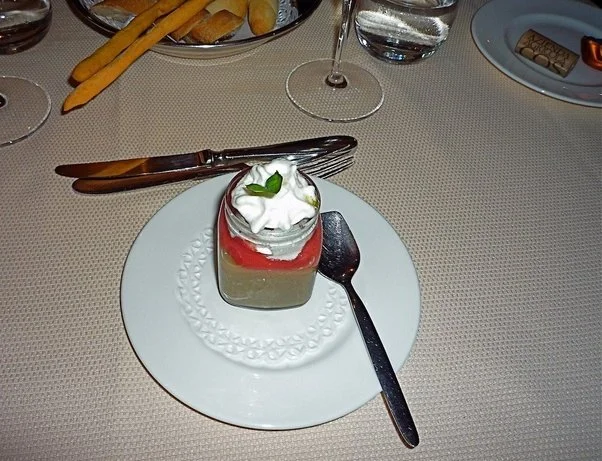
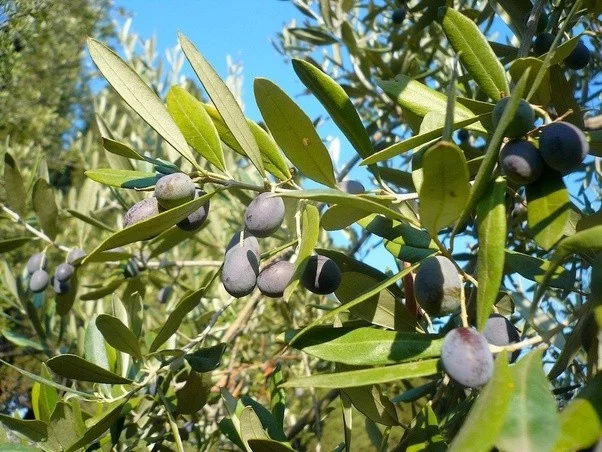


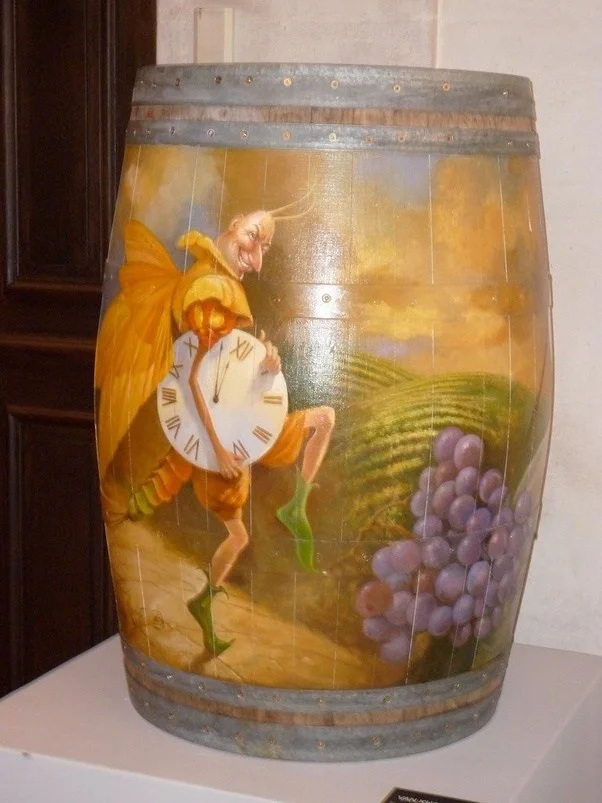
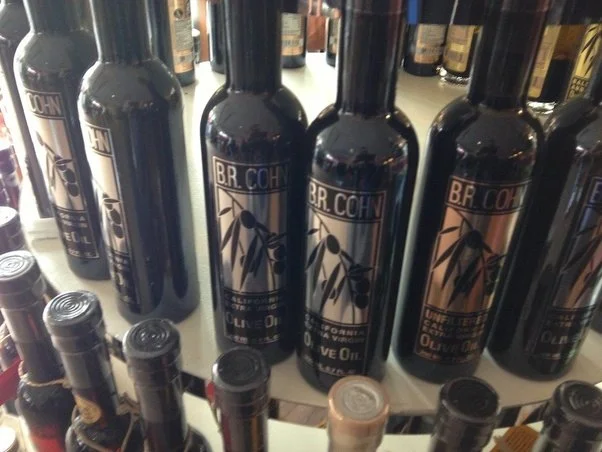
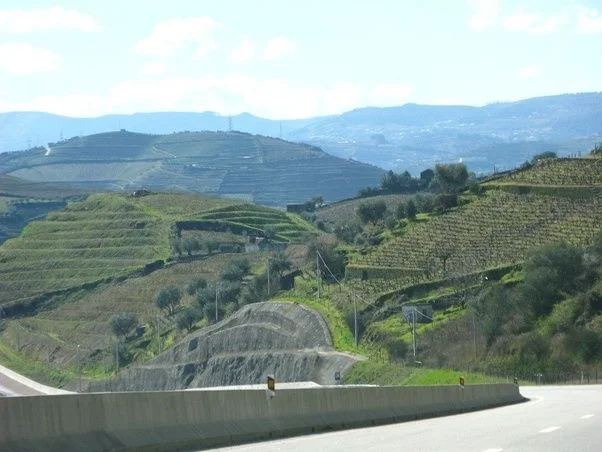

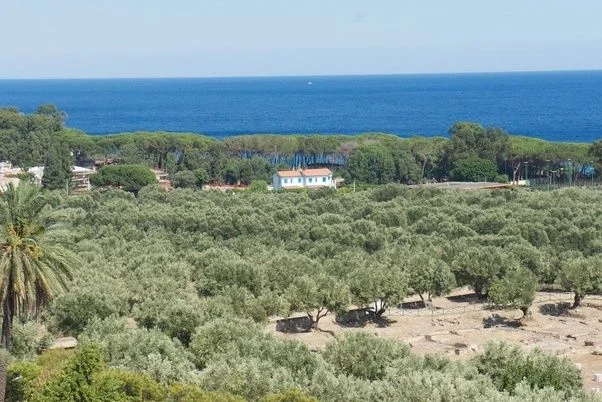
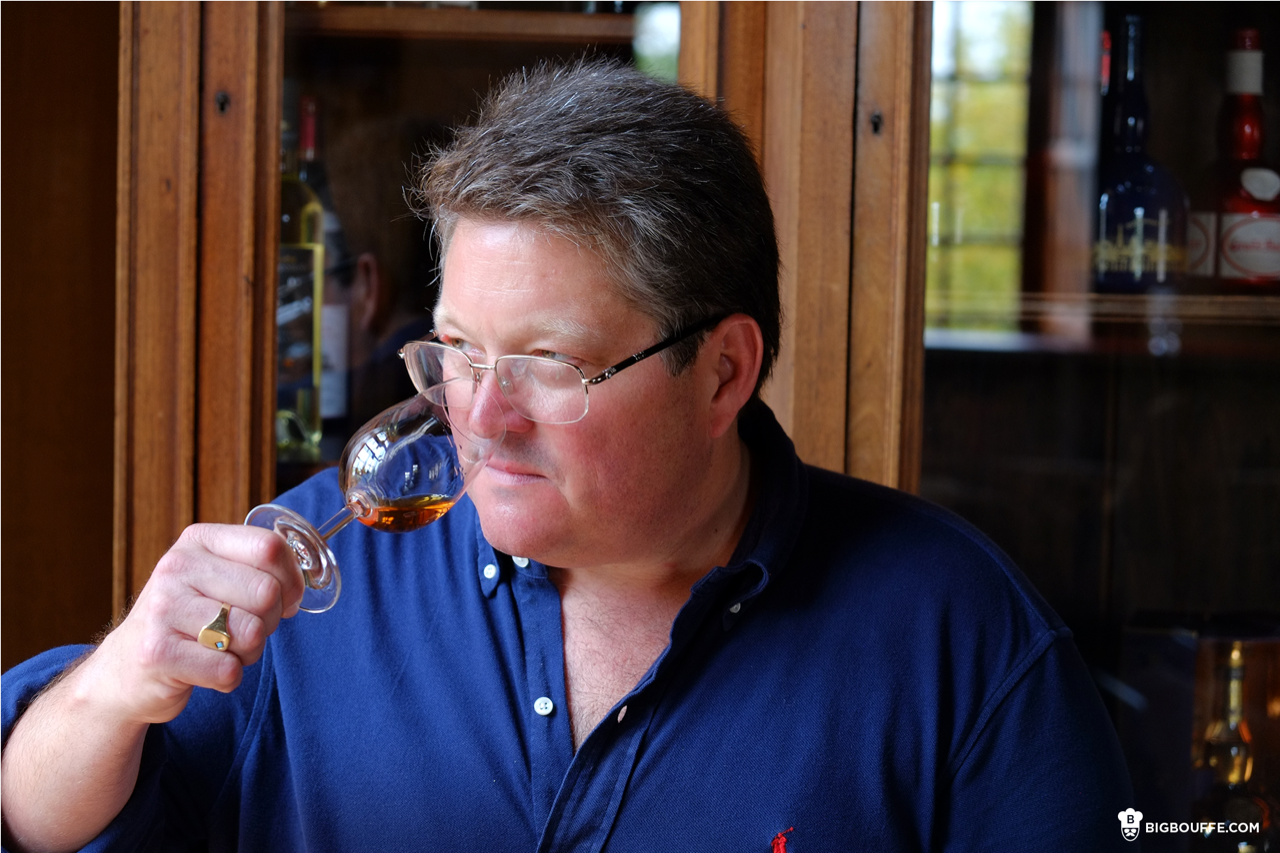


My first Father’s Day.